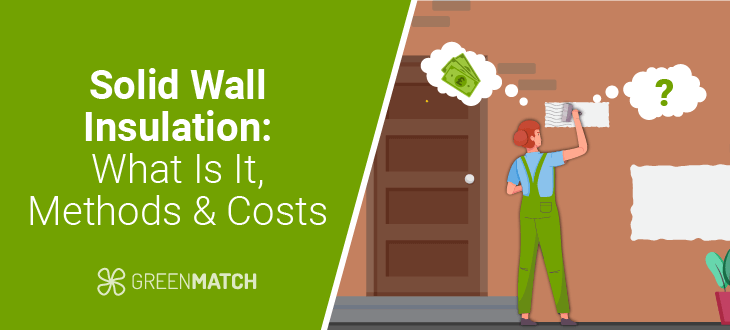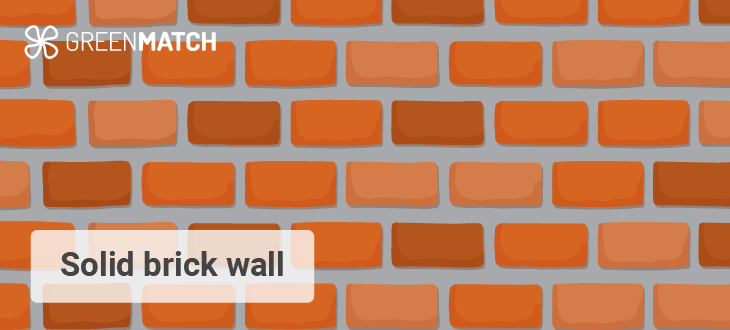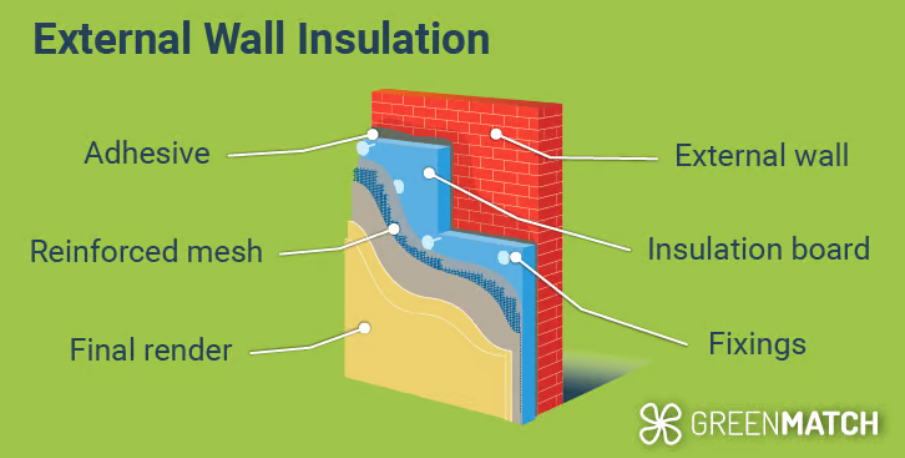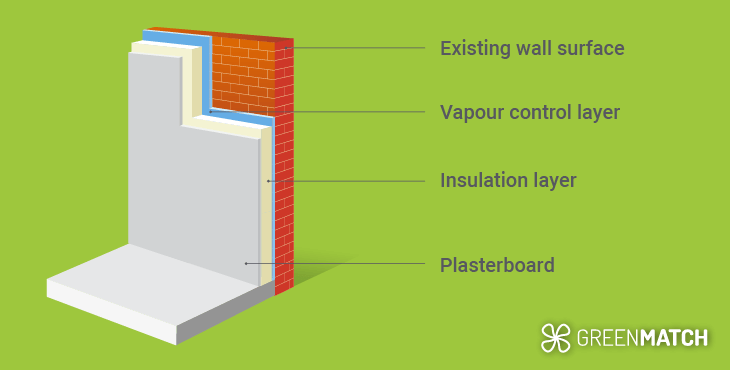Answer these simple questions and we will find you the BEST prices
Which type of solar quotes do you need?
It only takes 30 seconds
100% free with no obligation

Get Free quotes from insulation specialists near you

Save money by comparing quotes and choosing the most competitive offer

The service is 100% free and with no obligation
- GreenMatch
- Insulation
- Wall Insulation
- Solid Wall Insulation
Solid Wall Insulation: What Is It, Methods & Costs


- Solid wall insulation can reduce energy bills by up to £700 a year and cut carbon emissions by up to 2,100 kg annually.
- Solid insulation costs between £7,500 and £12,000, depending on whether you choose internal or external insulation and the size of your property.
- Grants such as the ECO4 Scheme, Great British Insulation Scheme, and Warmer Homes Scotland Scheme can significantly reduce the cost of solid wall insulation for eligible households, providing opportunities for financial assistance.
Although only 30% of homes in the UK have solid walls, a staggering 97% remain uninsulated, making them a significant source of energy inefficiency. Poorly insulated walls are the leading cause of home heat loss, accounting for up to 35%. With the rising cost of living and nearly 4 in 10 people struggling to pay their energy bills, proper wall insulation has never been more essential.
Solid wall insulation offers an effective solution to enhance homes' energy efficiency and comfort, especially those older properties built before the 1920s that lack the extra insulation layer found in modern cavity walls.
In this guide, we will explore solid wall insulation and the various methods available for both internal and external insulation. We will also provide a detailed breakdown of the costs involved. Whether aiming to cut down on energy expenses or make your home warmer, understanding solid wall insulation is a crucial step toward achieving a more energy-efficient living space.
Want to make your home more energy-efficient with solid wall insulation? GreenMatch has got you covered! We'll connect you with up to four free quotes from the best insulation specialists in your area, saving you the hassle of endless comparisons. Fill out our super quick 30-second form, and you'll have your quotes in no time. Click below to get started!
- Describe your needs
- Get free quotes
- Choose the best offer
It only takes 30 seconds



What is solid wall insulation?
Solid wall insulation involves insulating single brick walls to reduce heat loss and boost your home's energy efficiency. Unlike modern homes with cavity walls, which have two layers of bricks with a gap in between, solid wall homes are built with just one layer of material, like brick or stone, making them more likely to lose heat. With solid wall insulation, you can choose between internal or external wall insulation depending on your personal preference and budget.

There are a few key signs that can help you identify a solid brick wall. First, if your house was built before 1920, it likely features solid brick walls. If you're unsure of the age, check the exterior brick pattern—solid walls usually have bricks laid in a consistent, end-to-end pattern, unlike the alternating layers found in cavity walls. If your home's exterior is covered, you can measure the wall thickness; walls less than 260 mm thick are typically solid brick. For absolute confirmation, consulting a specialist is the best approach.
Solid wall insulation offers impressive benefits, reducing heat loss by up to 35% and saving you as much as £700 a year on energy bills, depending on your home's type and the insulation used. It can also lower your carbon footprint by up to 2,100 kg annually. Beyond saving you money and helping the environment, insulating your solid brick walls can boost your property's value by up to 14%. Solid wall insulation makes your home warmer and more comfortable, enhances its value, and contributes to a greener future.
How to insulate solid brick walls
With solid brick wall insulation, you can choose between internal or external wall insulation, depending on your budget and personal preferences. Each method has its pros and cons, so it's essential to understand what each entails to decide on the most effective solution for your home.
External solid wall insulation

External wall insulation involves attaching insulating materials to the outside of your home and covering it with a protective layer, such as render or cladding. This method consists of several layers and includes:
- Adhesive layer: Applied directly to the wall to firmly attach the insulation panels
- Insulation board: The main insulating layer that creates a thermal barrier, reducing heat loss.
- Reinforcement layer: Adds strength to the system, preventing cracks and damage.
- Fixing anchor and glass mesh: Securely fastens the mesh to the insulation boards.
- Primer: Waterproofs and smooths the surface for the topcoat.
- Finishing render layer: Provides a finished look and protects against weather and damage.
External wall insulation is the most effective method for insulating solid brick walls, as it creates a continuous thermal barrier around the entire building, significantly reducing heat loss and offering protection against weather-related damage. This leads to greater energy savings and a substantial reduction in your home's carbon emissions.
In addition to enhancing thermal efficiency, the continuous barrier adds an extra layer of protection against weather conditions, helping to prevent dampness and water infiltration. However, this method can be costly due to the extensive labour, materials, scaffolding, and waste removal involved. The installation process can also be disruptive, often requiring several weeks to complete, especially in bad weather, which may restrict access to certain parts of your home during this period.
While external insulation can refresh the appearance of your home by covering up signs of weathering, this could be a disadvantage for traditional or historic properties, as the render may alter the original features and make them look more modern. In such cases, planning permission might be necessary, particularly if your home is in a conservation area.
Another potential drawback is the risk of dampness. Since solid walls allow water vapour to pass through them and release moisture via ventilation or draughts, adding external insulation can block this natural process, increasing the risk of condensation if not handled correctly. Therefore, using breathable insulation materials is essential to prevent damp issues and ensure the walls can still expel moisture effectively.
- Provides the best thermal efficiency
- Has the biggest reduction of carbon emissions
- Protective layer against weathering
- Provides home with a fresh new look
- High-cost
- Risk of dampness
- Planning permission may be required
- Installation can be disruptive
Internal solid wall insulation

Internal wall insulation involves installing insulation materials inside your home's walls. This is typically done by attaching insulation boards or building stud walls filled with insulating material. Once the insulation is in place, a layer of smooth plasterboard is added to create a finished surface ready for painting or wallpapering. This method includes several essential layers.
- Existing wall surface: The original interior wall made of brick, stone, or other materials.
- Vapour control layer: Prevents moisture build-up, reducing condensation and dampness.
- Insulation layer: The main thermal barrier that minimises heat loss.
- Plasterboard or internal finish: The final smooth, decorative surface, usually plasterboard.
Internal solid wall insulation is the most cost-effective way to insulate your home, often up to 50% cheaper than external insulation. This makes it an ideal option for budget-conscious homeowners. One advantage is that you can selectively insulate only the walls that need it, reducing costs further, as interior walls between rooms generally don't need insulation unless there’s a need for soundproofing or temperature control.
When properly installed, internal insulation can last up to 25 years, providing long-term energy savings. It’s particularly beneficial for older homes with solid walls, as breathable insulation materials help release moisture, reducing damp issues.
However, there are some drawbacks. Installation can be disruptive, making rooms unusable until the work is finished, and it reduces room space by up to 100mm, which might be an issue in smaller areas. Improper installation can also trap moisture, causing condensation or dampness if not correctly ventilated. Fixtures like electrical outlets and radiators must be removed and reinstalled, adding to time and cost. Although effective, internal insulation is less efficient at reducing heat loss compared to external insulation.
- Last up to 25 years
- Cost-effective
- Can choose which walls to insulate
- Does not change external features
- Reduces internal space
- Risk of moisture due to improper installation
- Fixtures need to be removed
- Not as thermally efficient as external wall insulation
Which insulation method is best for your home?
Choosing the right solid wall insulation method depends on your budget, property type, and insulation goals.
External wall insulation is the most effective form of solid wall insulation for reducing heat loss and improving energy efficiency, as it creates a continuous thermal barrier around your home. It’s ideal for properties with solid brick walls and provides extra protection against weather damage. However, it’s more expensive and can change your home’s exterior appearance, making it less suitable for historic or listed buildings.
Internal wall insulation is a more budget-friendly form of solid wall insulation and allows you to insulate specific rooms. This option enhances energy efficiency without altering your home’s exterior. However, it’s less effective at reducing heat loss than external insulation. It can be disruptive, as it slightly reduces indoor space.
External solid wall insulation is the best choice if you’re looking for maximum thermal efficiency and have the budget. For a more affordable option that maintains your home’s exterior appearance, internal solid wall insulation may be more suitable. Consulting a professional can help you choose the ideal insulation method for your home's needs.
Let GreenMatch connect you with up to four free quotes from the best insulation specialists in your area, saving you the hassle of endless comparisons. Fill out our super quick 30-second form, and you'll have your quotes in no time. Click below to get started!
- Describe your needs
- Get free quotes
- Choose the best offer
It only takes 30 seconds



Solid wall insulation cost

Solid wall insulation cost varies greatly depending on whether you opt for internal or external insulation and factors like the size of your home and the materials used.
External wall insulation costs around £12,000 for an average three-bedroom semi-detached house. This higher price is due to the extensive labour, materials, and the need for scaffolding. On the other hand, internal wall insulation costs about £7,500 for a similarly sized property, making it more affordable since it requires fewer materials and is less labour-intensive.
It's essential to recognise that labour constitutes approximately 60% of the total cost for solid wall insulation. More significant properties or complex installations will increase labour costs, with insulation specialists typically charging around £250 per person daily.
Despite the initial investment, solid wall insulation can lead to substantial energy savings, reducing annual bills by £140-£700, making it a smart long-term investment. Below, you’ll find potential savings based on different household types, illustrating the financial benefits of choosing solid wall insulation.
| Property type | Estimate costs | Annual energy savings |
|---|---|---|
| Apartment | £6,000 to £10,000 | £140 to £190 |
| Terrace house | £8,000 to £12,000 | £170 to £240 |
| Semi-detached house | £10,000 to £16,000 | £290 to £405 |
| Detached house | £15,000 to £22,000 | £500 to £700 |
Solid wall insulation grants
Solid wall insulation can be a significant investment, with costs ranging from £7,500 to £12,000 or more, depending on whether you choose internal or external insulation. While the upfront expense may seem high, the long-term financial benefits are substantial, with potential savings of £140-£700 per year on energy bills, making it a worthwhile investment over time.
Fortunately, there are grants for solid wall insulation available that can offset the initial costs:
- ECO4 Scheme: Requires large energy companies to help low-income households with energy efficiency. Eligibility depends on income, benefits, and energy rating.
- Great British Insulation Scheme: Available in England, Wales, and Scotland, this grant offers free or low-cost insulation. Eligibility depends on EPC rating and Council Tax bands.
- Warmer Homes Scotland Scheme: TThis Scottish grant covers insulation, draught proofing, and heating for eligible households, focusing on families meeting specific criteria or benefits. Eligibility includes homes in Council Tax bands A-F, up to 230m2, or with a low EPC.
- Affordable Warmth Scheme (Northern Ireland): Assists low-income individuals in private homes with energy efficiency improvements. Open to private homeowners or renters with an income of £23,000 or less.
The easiest way to determine if you're eligible for grant schemes and cut down on solid wall insulation costs is to work with an expert. But finding the right specialist that fits your needs and budget can be a hassle. That’s where GreenMatch steps in! We'll connect you with up to four free quotes tailored to your needs and budget. All you need to do is fill out our quick 30-second form to obtain these quotes. Click below to learn more!
- Describe your needs
- Get free quotes
- Choose the best offer
It only takes 30 seconds



FAQ
Yes, solid wall insulation is highly effective in reducing heat loss up to 35%, improving energy efficiency, and lowering energy bills in homes with solid brick walls.
The cheapest way to insulate a solid wall is by using internal wall insulation, which involves attaching insulation boards to the inside of your walls.
To insulate a solid brick wall internally, you attach insulation boards or build a stud wall filled with insulating material on the interior side of the wall.
To insulate a house with solid stone walls, you can apply either internal insulation using insulation boards or a stud wall, or external insulation by attaching insulation material to the exterior and covering it with a protective render or cladding.
Solid wall insulation typically costs between £7,500 to £12,000, depending on whether you choose internal or external insulation and the size of your property.

Caoimhe is an experienced content writer and researcher who is passionate about providing accessible information to every reader. With a background in English literature and Sociology, she combines the two disciplines to create cohesive, well-thought-out, and well-informed pieces.
We strive to connect our customers with the right product and supplier. Would you like to be part of GreenMatch?

